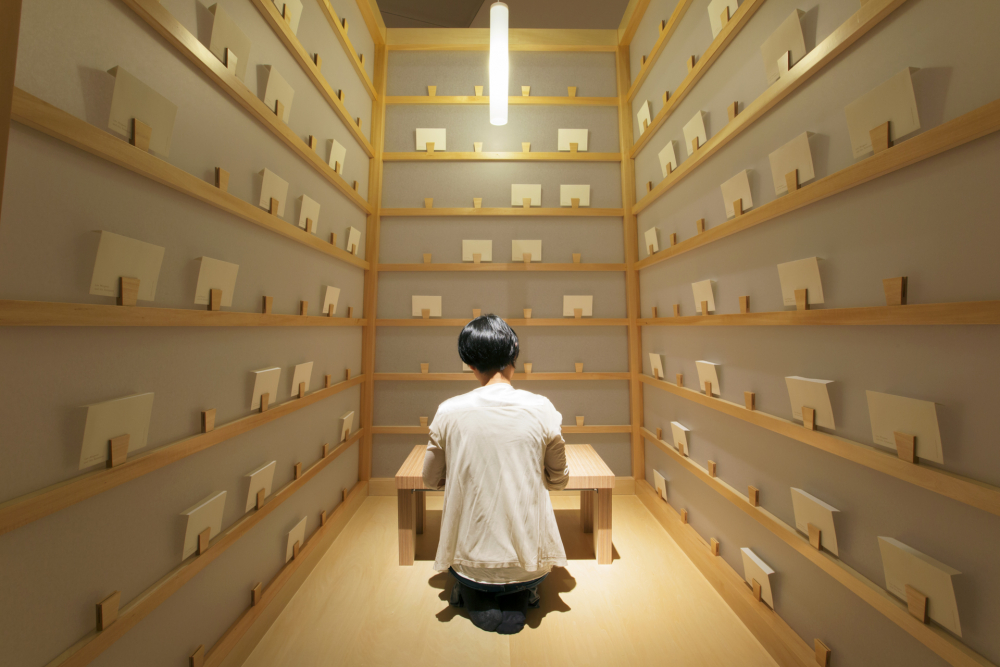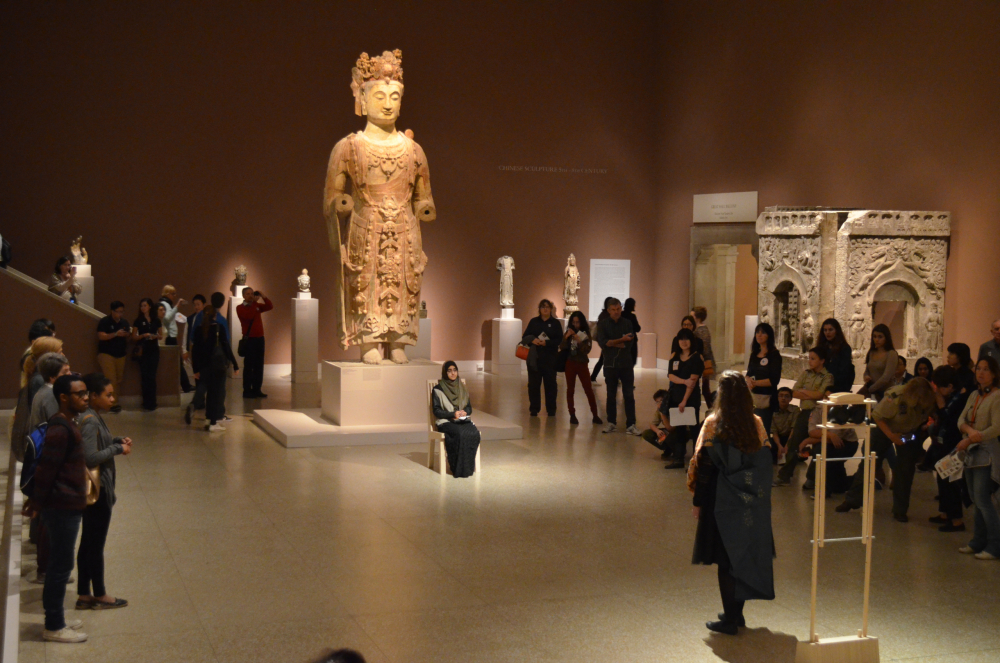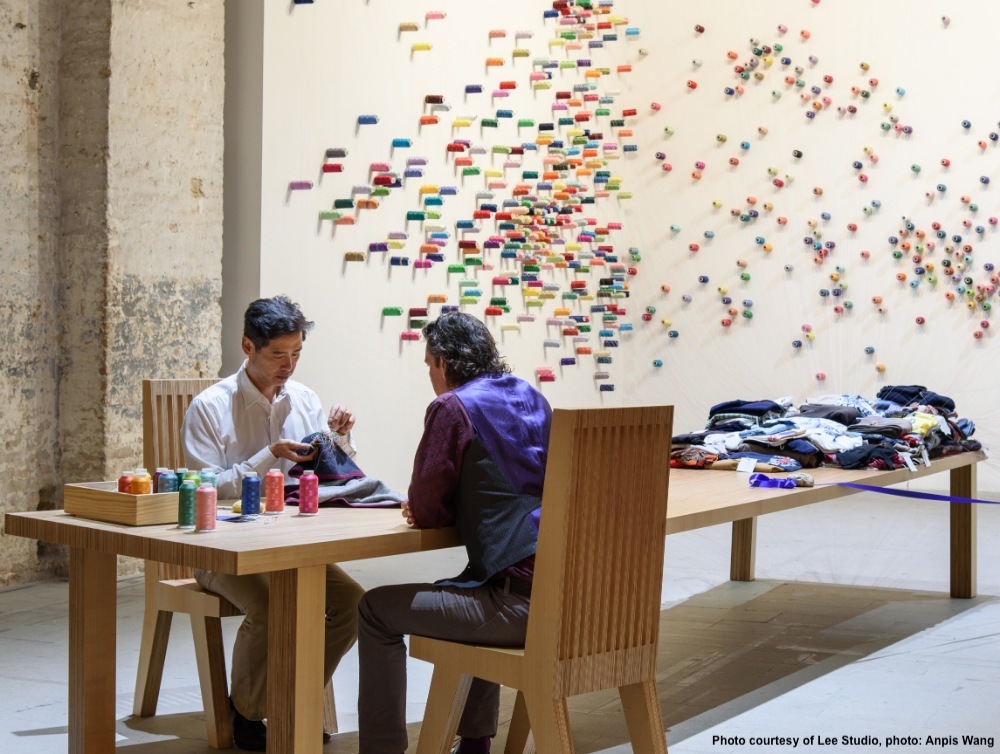Many artists have long been rethinking the boundaries of cultural institutions like museums, and how to redraw these borders through visionary lenses to closely interact with the public. Artists who encourage museums to be more attuned to societal challenges, in a way, are rethinking how cities could mindfully listen to their citizens, and to one another, using the analogical sphere of public institutions.
Various artists and avant-gardes have sought through countless approaches to reconceptualize the boundaries within where art is viewed beyond static confines, where the public is solely engaging with heritage. These innovators are increasingly empowered to push boundaries and, with fervent valor, to take over the standardized box, the white cube, the brick and mortar space, and creatively elicit the participation of people in exhibitions, specially those who might not usually visit museums. These actions are no longer about just viewing, but extending oneself into multi-sensory works that embrace all-encompassing sensations that envelope the passive viewer. It is an invitation for visitors to become a part of the exhibition -the ultimate goal in connecting the imaginary thread between viewer and maker.
An artist’s invitation to the public
An artist thoughtfully making work in this realm is the artist Lee Mingwei. He not only wants to interact with visitors at museums, he brings people together through different projects around the world, often inviting a mix of professional artists and local emerging artists to create a shared experience. The artist describes how many of these ideas are born from the dream state, perhaps the most vulnerable state, allowing the ideas to evolve and shift.

Isabella Shaw, Johanna Isokoski, Meri Siirala, Olivia Moss, Rachel McIntosh / Avajaiset 23.9.2021 / Kuva: Kansallisgalleria / Jenni Nurminen
In these series of projects, the notion of care comes through as a continuous motif. Care for the self, for the neighbor, for the stranger, turning the museums’ space into a place of dialogue in our cities. Care for the work, for the fragments and moments peppered with silence and sound, meditation and movement.
Lee speaks of these moments as gifting a song to a stranger, slowly and deliberately, with attention and intention, and also gifting the visitor a space of meditation in the midst of the city.
He describes “drawing from a quiet and tranquil place”, and when in collaboration with dancers, musicians and performers, the thought behind it akin to “giving a song to a stranger, with attention and with intention”. Much of his practice considers transformative elements, as he is “interested in the moments of change”.
His recent exhibition and on-going collaboration, Sonic Blossom makes emotion a highly tangible sensation because of the nature of the work. In collaboration with local opera singers in different cities, where this performative work has toured, the singers meander in the museum finding a visitor who they think might enjoy receiving an opera song exclusively for them. This touching experience caused all kinds of emotions in people at venues including Centre Pompidou in Paris, Metropolitan Museum of Art in New York, and Mori Art Museum in Tokyo, Museum Villa Stuck in Munich, and most recently on view this fall at Ateneum Finnish National Gallery.
Removing walls and building personal connections
Another wonderful element of Lee’s work is how space is reconceptualized. While spatial interiors and exteriors are obviously considered, both through the staging of an institution’s exhibition space, or through the outdoor configuration, of equal significance is the space around a viewer, and in between two or more viewers, or the viewer and the artist. This dynamic explores tension, comfort, proximity, time, and headspace. It reconsiders how humans engage on intuitive levels, channeling connectivity through micro-actions.

Installation view at “Lee Mingwei and His Relations”, Mori Art Museum, Tokyo, 2014 / Photo: Yoshitsugu Fuminari
There is a sense of intimacy in much of his work – a very human connectedness that feels rejuvenating. The slow, methodical gestures, the tension of movement, body language, and focal concentration are all commitments to the actions taking place, and to relinquish oneself while remaining within the moment.
This activation of agency through simple requests or tasks are a delicate play of participatory art: the invitation to write a letter, share a meal, take a walk, break a ceramic vessel, read bedtime stories, mend an article of clothing…they prompt introspection. They are also acts of self-care, or selfless caring for strangers. Utilizing art through such actions could benefit people in significant ways, as permanent fixtures in society.
In The Letter Writing Project Lee encourages visitors to write a thank you, insight, or apology to either an absent loved one or somebody they always wanted to write to. If the visitors leave a sealed and addressed envelope in the booths, it will be sent by the museum. If the letter is left open for others to read, it will go into Lee’s collection. In The Mending Project, through the communication channels of the museum, participants are asked to bring to the museum a piece of clothing which they have come to love and wanted to be repaired. Menders have one-to-one conversations with each of the participants while they repair or decorate their clothes.
The weaving of actions into collective tapestries
Lee utilizes music, the sound of breakage, movement, the cityscape, and the sound of participants, as well as ambient sounds of meditation in his various projects over the years. The absence of sound is just as important as the production or reverberation of it. Each auditory component is a note on a scale, a beat to a track, an orchestra so intricately woven that the fibers interlock much like a sonic tapestry.

Installation view at “Lee Mingwei: Sonic Blossom,” The Metropolitan Museum of Art, New York, 2015 / Photo: Lee Studio
In our conversation, Lee described how he considers himself to still adhere to his textile background by “weaving through a social context”, and how it’s morphed conceptually, while the philosophies have remained consistent throughout the years. We discussed how textiles, and ceramics, another recurring aspect of the artist’s practice, harken back as some of the earliest artforms, and across the world, and are among the touchstones present in the raw, tangible beauty that is reflective in Lee’s pieces.
The career of Lee began in the 1990’s, where he studied architecture and textile art at the California College of Arts and Crafts, graduating with honors in 1993, before earning an MFA in Fine Arts in sculpture at Yale University in 1997. These formative years shaped a successful career, rooted in conceptual and participatory art, that have been presented in locations across the globe at various institutions. Early projects at Yale included Reflections and The Dining Project, which chartered voluntary journeys of solitary introspection and togetherness through shared moments of communal participation of an event.
In Reflections, viewers enter separate spaces with a dual mirror, superimposing the reflection of the previous side onto that of the other person. This activation removes the personal walls or boundaries that one puts up, driving the participants to see themselves in a new light. In The Dining Project a dining host would cook a meal for a stranger and they would dine and converse at the museum after closing hours, again gifting an exchange between strangers.

Installation view at “Lee Mingwei and His Relations”, Mori Art Museum, Tokyo, 2014 / Photo: Yoshitsugu Fuminari
Other projects such as Money For Art invited people to connect on personal levels and ascribe value to the project as they chose. Some visitors would trade objects that they deemed to be the monetary equivalent of what the art object (also made out of money) was, leaving an array of everyday items as a barter exchange dialogue with the artist. A positive aspect of this, as Lee recalls, was how people who were unable to otherwise afford art could collect this work and travel around with a collection of small sculptures. Such equitable means are one of the endearing aspects of Lee’s practice.
Through minimal materials and palettes, the aesthetic is clean, and sparse, leaving room for the complexity of ideas and emotions to unfold in spiritual and philosophical ways. The spaces, like the ideologies that are the skeletal core of the art, are evocative and spun with a sense of sacredness. Each step taken by a dancer or performer is as important as each note played by the musician. Lee leads these professional artists and musicians as a conductor might lead an orchestra, or a director a theater or film crew.
The artist described how trust and collaboration are paramount to making it all come together to create meaningful experiences. This carving of space, the hollows make room for a sacredness amidst the seeming mundanity of life – a poignant reminder to slow down in our fast-paced urban lives and appreciate the in-between moments, which could change our lives.





